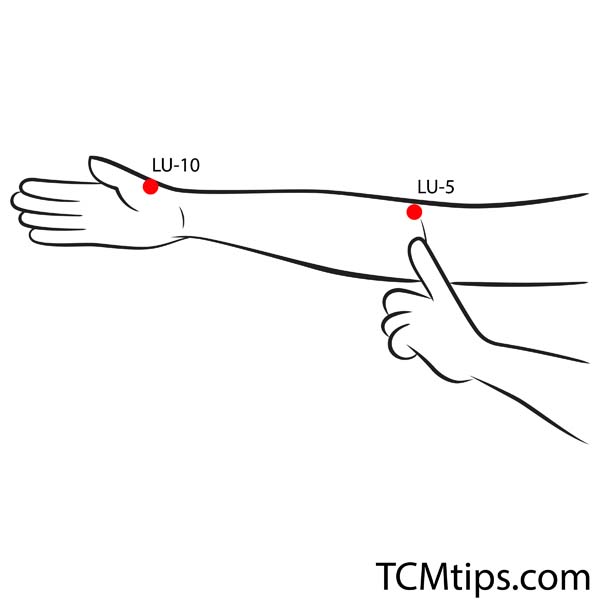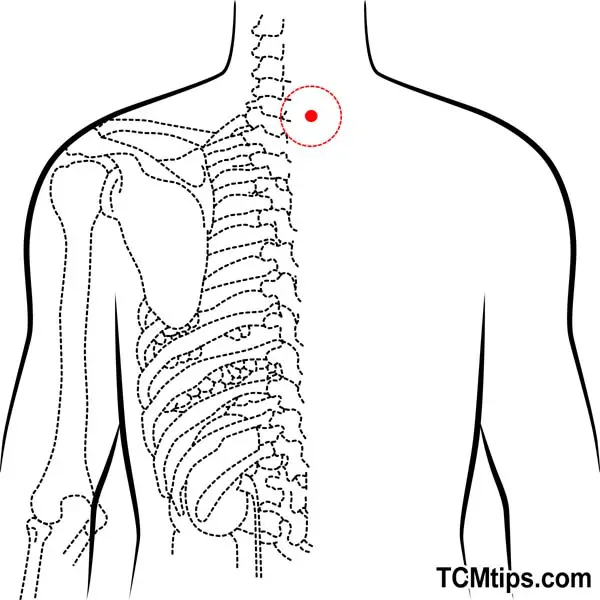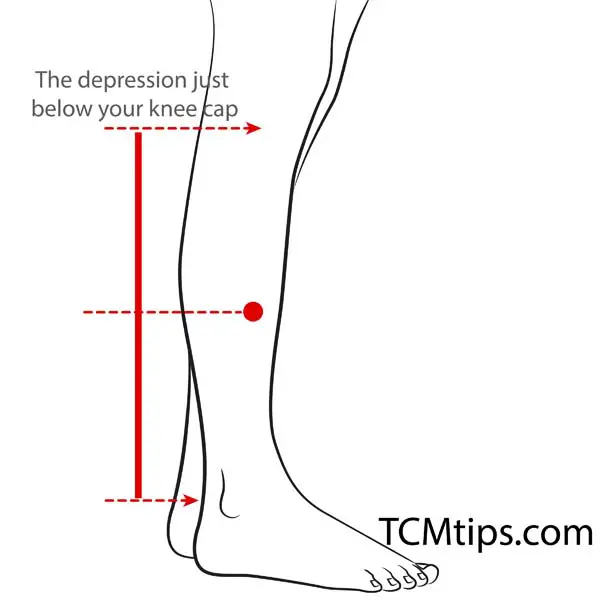If you’re feeling a bit under the weather, there’s no need to reach for medication right away. Before you pop a pill, why not try acupressure? This ancient practice is said to be able to relieve all sorts of ailments, from headaches to back pain. By applying pressure to these acupressure points for throat inflammation, you can help to ease discomfort and promote healing.
Acupoint: LU-5 (Other Names: Lung-5/Chi Ze/Cubit Marsh)

The acupoint LU-5 is known as “Chize” which means “Cubit Marsh.” LU-5 is situated on the transverse cubital crease, on the radial side of the biceps brachii tendon.
Acupoint LU-5 is classified as the He-Sea point of the Lung Meridian. This acupoint is one of the acupressure points for throat inflammation that clears lung heat, increases the descending motion of Lung Qi, expels Lung phlegm, helps the bladder, and relaxes the sinews. A
Acupoint LU-5 is an important pressure point for tonsils and is useful in various clinical conditions such as:
– cough
– hemoptysis
– fever
– asthma
– sore throat
– body aches
– chest heaviness
– infantile convulsions
– spasmodic elbow
– arm discomfort
– mastitis
Because throat pain is generated by heat in the lungs and stomach, it develops gradually. It also rises and falls and is intimately tied to lifestyle choices such as smoking, eating, and drinking. Because the throat is a portion of the respiratory tube dominated by the lung, the LU-5 acupoint from the lung channel is selected to treat throat inflammation.
A clinical research reported that acupoint LU-5 was used to treat a patient who experienced an asthma attack during her weekly acupuncture treatment on a few other acupoints. The patient did not experience an asthma attack afterward in her remaining sessions.
Apply strong and consistent pressure to the LU-5 point on your left elbow crease with your right thumb for around 30 seconds. For 30 seconds, apply continuous pressure with your thumb to this location toward the outer side of the crease. Repeat the procedure 3–4 times on your right elbow, using your left thumb.
Acupoint: Ren-22 (Other Names: The Conception Vessel-22/Tian Tu/Heaven Projection)

The acupoint Ren-22 is known as “Tiantu” which means “Celestial Prominence.” Ren-22 is situated in the center of the suprasternal fossa, on the anterior median line of the neck.
This acupoint stimulates the descent of Lung-Qi, clears heat, stops coughing, clears phlegm, benefits the throat, and calms asthma. Being one of the acupressure points for throat inflammation, acupoint Ren-22 is helpful with asthma, cough, sore throat, dry throat, hiccups, sudden hoarseness, swallowing trouble, and goiter.
Ren-22 is a collarbone pressure point that is also commonly used to treat throat and voice-related symptoms such as throat dryness, edema, and ulcers, as well as voice loss.
Locate the acupoint and apply mild pressure for 3 seconds to activate Tiantu’s therapeutic benefits. Do this twice at a time, being careful not to push too hard because the throat is fragile. Due to its proximity to the trachea, time the pushes to match your breath. Press when exhaling and release pressure when inhaling.
Acupoint: EM-20 (Other Names: Dingchuan/Stop Asthma)

The acupoint EM-20 is known as “Dingchuan” which means “Stop Asthma.” EM-20 is situated 0.5 cun lateral to the lower border of the spinous process of the 7th cervical vertebra on the back.

You can relieve symptoms of asthma and stop coughs by applying pressure on acupoint EM-20. Being one of the acupressure points for the lungs, this acupoint is beneficial for relieving conditions like throat discomfort, asthma, cough, chest tightness, and shortness of breath.
A double-blind, randomized controlled trial was conducted on 40 male patients with moderate chronic bronchial asthma. According to the findings of this study, Acu-TENS therapy at bilateral Ding Chuan (EM-20) acupoints for 4 weeks is an effective technique for improving lung function in men with chronic bronchial asthma.
The most basic technique is to apply firm pressure at EM-20. For 1-2 minutes, apply consistent, stationary pressure to the point with your thumbs, fingers, palms, side of your hand, or knuckles.
Acupoint: ST-40 (Other Names: Stomach-40/Feng Long/Abundant Bulge)

The acupoint ST-40 is known as “Fenglong” which means “Abundant Bulge.” ST-40 is situated 8 cun superior to the external malleolus, lateral to ST 38, two finger-breadths (middle finger) from the anterior crest of the tibia.
ST-40 is classified as a Luo-Connecting point of the Stomach Meridian and is one of the acupressure points for throat inflammation that transforms phlegm and dampness, alleviates coughing and wheezing, relaxes the shen and clears phlegm from the Heart, activates the meridian and energy flow, and relieves pain. This acupoint is useful for conditions such as cough, phlegm accumulation, asthma, manic psychosis, epilepsy, dizziness, headache, and lower extremity paralysis or weakness.
Apply gentle pressure on the ST-40 with the tip of your thumb. You may experience a little discomfort, but do not let this intimidate you. Apply pressure for 5 seconds and then release. Repeat the steps ten times on each leg, targeting the ST-40 acupoint. This acupoint is easily activated with either acupuncture or acupressure. It can even be activated at home for immediate throat relief.
Acupuncture has been shown in studies to lessen the negative effects of cancer treatments, resulting in a higher quality of life. Acupuncture therapy on a regular basis helps improve dysgeusia and discomfort in postradiated patients with head and neck cancer.
The ST-40 is also effective for patients that have trouble and pain while swallowing. A clinical research study reported that routine acupuncture therapy at a few acupoints, including ST-40, resulted in a cumulative response that included a complete improvement in the patient’s sensation of taste and moderate pain relief.
This improvement was most likely caused by acupuncture’s anti-inflammatory effects via anti-inflammatory mediator production, an antipain effect via ß-endorphin secretion, and nerve-cell regeneration by neurotrophic factor secretion. ST-40 is also one of the acupressure points for good digestion during menopause.
Acupoint: Ren-23 (Other Names: The Conception Vessel-23/Lian Quan/Lateral Spring)

The acupoint Ren-23 is known as “Lianquan” which means “Corner Spring.” Ren-23 is situated above the throat prominence, in the depression above the top border of the hyoid bone, on the anterior median line of the neck.
Ren-23 is classified as the crossing point of the Ren and the Yin Wei Vessels. Ren-23 is one the most important acupressure points for throat inflammation that subdues rebellious Qi, soothes the tongue, throat, relieves cold symptoms, clears phlegm, and prevents coughing.
This acupoint helps with conditions such as subglossal swelling and soreness, salivation with flaccid tongue, aphasia with the tightness of the tongue, sudden hoarseness of the voice, and difficulty in swallowing.
It influences body fluid production in the mouth due to its unique placement at the base of the tongue. As a result, it can be used to treat throat and mouth dryness, as well as relieve flu symptoms.
Maintain pressure on Ren-23 for 30 seconds to three minutes with your thumb or index finger (or even your fingernail). The specified period of acupressure can range from five seconds to 15 minutes. When you stimulate this acupoint with your thumb, saliva will flow out and help to moisten your throat. You might also expect the impact of reducing coughing that persists after the cold has subsided.
In Traditional Chinese Medicine, acupuncture therapies for poststroke rehabilitation, including aphasia, are widely used. Aphasia is a neurological disorder that impairs your capability to communicate. It can also have an impact on your speech.
Ren-23, as well as numerous other acupoints, are commonly used in the treatment of Poststroke Aphasia. For a couple of months, acupuncture treatments should be quite frequent, ideally daily, or at least 2–3 times per week.
According to a literature study, Lianquan (CV-23) is mostly utilized to treat throat disorders through syndrome-meridian differentiation. The addition of complimentary acupoints or five-shu points to CV-23 has a synergistic effect. Moxibustion is frequently used in conjunction with needle therapy.

Try our Anti-Aging Gua Sha Tool designed to bring out your skin’s natural glow.
Best Gua Sha Product- Anti-Aging: The tool is designed to target 11 specific aging signs such as wrinkles and sagging skin. By following the 7-step routine, users can improve skin firmness and reduce fine lines naturally.
- Enhances Skincare Routine: It works effectively with serums and lotions, boosting absorption and efficacy of skincare products.
- Visible Skin Improvement: Users can expect a smoother complexion, reduced puffiness, and a more youthful appearance.
 P. Sze
P. Sze 

















